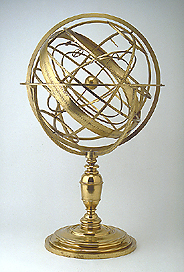
 |
| Catalogue |
 |
 Armillary Sphere The outer edge of the horizon ring carries the names of the cardinal directions and the winds in the half-quarter directions: 'SEPTENTRIO', 'C?CIAS', 'ORIENS', 'EVRVS', 'MERIDIES', 'AFRICVS', 'OCCIDENS' and 'CORVS'. The zodiacal band is engraved on the upper side, and the twelve signs are numbered with Roman numerals and supplemented with their traditional astrological symbols and that of the ruling planet. Adjacent is a calendar scale (Gregorian) and an hour scale with the hours indicated by Roman/Arabic numerals and each hour divided into eight equal parts. Sliding perpendicular in the horizon ring and resting on the central pillar is the meridian ring with latitude scales running up to 90? for setting the geographical latitude. Rotating inside the meridian ring is the celestial sphere formed by the rings of the celestial equator, the ecliptic (zodiac), the Tropic of Cancer, the Tropic of Capricorn, the polar circles and the colures passing through the equinoctial and the solstitial points. Thirteen bright or astrologically significant stars are listed on the celestial sphere, together with their magnitudes and planetary temperaments. The following star pointers are fixed to the solstitial colure and the Tropics of Cancer and Capricorn: 'lira', 'Hircus', 'dexter humerus Orionis', 'Canis maior', 'Corni [Aries]' and 'Arcturus'. Three unlabelled star pointers indicate the positions of 'Algol', 'Deneb' and 'Fomalhaut'. Listed on the zodiacal band are 'Oculus [Taurus]', 'Cor [Leo]', 'Spica' and 'Cor [Scorpio]'. Revolving inside the celestial sphere are two rings carrying the Sun (represented as a disk with flamed rays) and the Moon (fixed on a small wheel to allow for the Moon's motion above and below the ecliptic). In the centre is a brass sphere (50 mm in diameter) representing the Earth on which are engraved the equator, the tropics, the polar circles and a (projected) zodiac. The instrument maker's signature is found on the edge of the horizon circle: 'Gio: Paolo Ferreri .F. Anno .MDC.' The instrument (previously catalogued as A 460) has been on loan from the Rijksmuseum of Amsterdam since 1957. See D. J.Price, "A Collection of Armillary Spheres and other Antique Scientific Instruments", Annals of Science, 10 (1954), pp. 172-187, at p.179. Robert van Gent |



